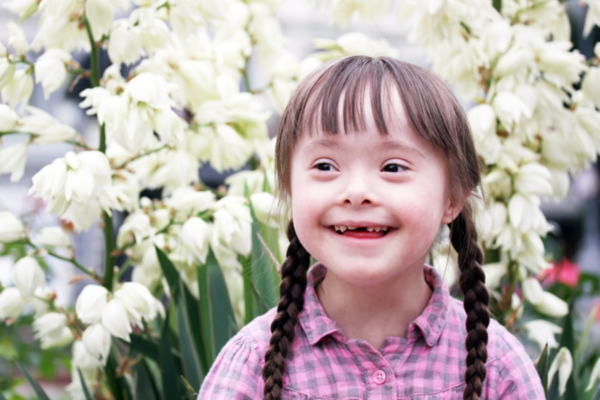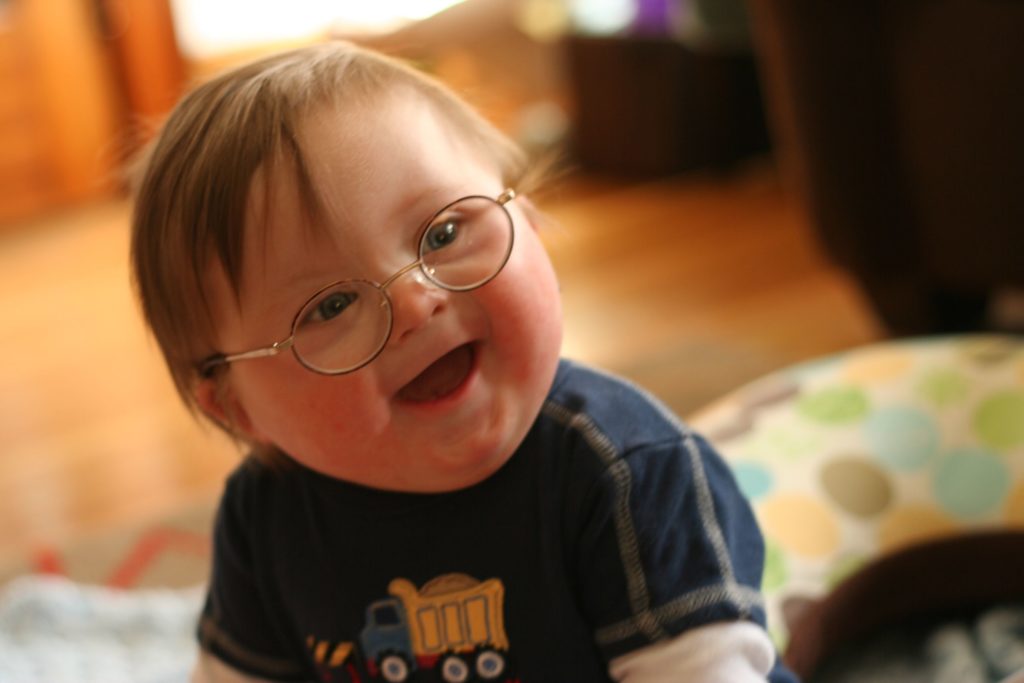Down Syndrome, also known as Trisomy21, is a disease caused by an abnormality in the chromosomes (cellular structures that contain the genetic material of the organism). People with trisomy 21 have three chromosomes 21 instead of a single pair. This imbalance in the functioning of the genome (all hereditary information present in human cells) and the organism causes permanent mental retardation and developmental delay. Trisomy 21 may vary in severity. The syndrome is becoming better known and early intervention can make a big difference in the quality of life of children and adults affected. In the great majority of cases, this disease is not hereditary, that is, it is not transmitted from parents to their children.
Down Syndrome Mongolism
Down Syndrome owes its name to the English physician John Langdon Down who published in 1866 the first description of people with Down syndrome. Before him, other French doctors had made the observation. As the afflicted persons present characteristic traits of the Mongols, that is to say, a small head, a round, flattened face with narrowed, narrowed eyes, it was familiarly called this “Mongoloid idiocy” or Mongolism. Today, this denomination is rather pejorative. In 1958, French physician Jérôme Lejeune identified the cause of Down’s syndrome, namely, an additional chromosome on the 21st pair of chromosomes. For the first time, there is a link between mental retardation and a chromosomal abnormality. This discovery opened new opportunities for the understanding and treatment of many genetic mental illnesses.

Down Syndrome Causes
Each human cell contains 46 chromosomes organized in 23 pairs on which the genes are located. At the time of egg and sperm fertilization, each parent transmits 23 chromosomes to their child, in other words, half of their genetic baggage. Trisomy 21 caused by the presence of a third chromosome 21, caused by an abnormality during cell division. Chromosome 21 is the smallest chromosome: it has about 300 genes. In 95% of the cases of trisomy 21, this surplus chromosome is found in all the cells of the organism of the affected persons. Rare forms of Down syndrome caused by other abnormalities of cell division. In about 2% of people with Down’s syndrome, there are surplus chromosomes in only a part of the body’s cells. called trisomy 21 mosaics. In about 3% of trisomic persons, only part of chromosome 21 is supernumerary. This is trisomy 21 by translocation.

Down Syndrome Prevalence
In France, trisomy 21 is the leading cause of a mental handicap of genetic origin. There would be about 50 000 people with Down’s syndrome. This pathology would concern 1 birth out of 700 to 1000. Down Syndrome 21 would affect about 1 baby out of 770 births. All women may have a child with Down’s syndrome but the probability increases with age. At 20, a woman would have a risk of 1 in 1,500 having a child with Down’s syndrome. At 30, the risk is 1 in 1000. This risk would increase from 1 in 100 to 40 years and 1 in 28 to 50 years.
Symptoms of trisomy 21
From a very young age, a child with trisomy 21 has characteristic physical traits:
- A “flattened” profile
- Bent eyes
- An epicanthus (= skin folds above the upper eyelid)
- A flat nose bridge
- Hypertrophy and protrusion of the tongue (the tongue is abnormally advanced forward)
- A small head and small ears
- A short neck
- A unique fold in the palms of the hand called a single transverse palmar fold
- A small limbs and trunk
- Muscular hypotonia (= all muscles are soft) and abnormally flexible joints (= hyperlaxity)
- Slow growth and a size that is generally lower than that of children of the same age.
- In babies, a delay in learning such as turning around, sitting down, and crawling due to weak muscle tone. These learnings are generally double the age of children without trisomy.
- Mild to moderate mental retardation.
Down Syndrome Complications
Children with trisomy 21 sometimes suffer from certain special complications:
- Cardiac malformations: According to the Canadian Down Syndrome Society (SCSD), more than 40% of children with the syndrome have a congenital heart defect present at birth.
- Intestinal occlusion (or blockage) requiring surgery. It affects about 10% of newborns with Down’s syndrome.
- Hearing loss
- Susceptibility to infections such as pneumonia, due to a decrease in immunity
- An increased risk of hypothyroidism (low thyroid hormone), leukemia, or convulsions
- A delayed language, sometimes aggravated by the loss of hearing
- Eye and eye disorders (cataracts, strabismus, myopia or hyperopia are more frequent)
- An increased risk of sleep apnea
- A tendency to obesity
- In men afflicted, sterility. Pregnancy is, however, possible in most women.
- Affected adults are also more prone to the early form of Alzheimer’s disease.
Down Syndrome Diagnosis
The diagnosis of Down syndrome is usually posed after birth, in view of the baby’s features. However, to confirm the diagnosis, it is necessary to perform a karyotype (= test that allows studying chromosomes). A sample of the baby’s blood, taken to analyze the chromosomes present in the cells.
Down Syndrome Prenatal tests
Screening tests for all pregnant women assess whether the probability or risk of the infancy of Down’s syndrome is low or high. This test consists of a blood sample and then the analysis of the nuchal translucency, that is, the space between the skin of the neck and the spine of the fetus. This test takes place during an ultrasound between 11 and 13 weeks of pregnancy. It is safe for the fetus. Diagnostic tests for high-risk women indicate whether the fetus has the disease. These tests are usually performed between the 15th and 20th weeks of pregnancy. The accuracy of these techniques for Down syndrome screening is approximately 98% to 99%. Test results are available in 2 to 3 weeks.
Before taking any of these tests, the pregnant woman and her partner are also advised to meet with a genetic consultant to discuss the risks and benefits associated with these interventions.
Down Syndrome Amniocentesis
Amniocentesis makes it possible to determine with certainty whether the fetus has trisomy 21. This test is usually carried out between the 15th and the 22nd week of pregnancy. An amniotic fluid, taken from the pregnant woman’s uterus using a fine needle inserted into the abdomen. Amniocentesis involves certain risks of complications, which can go as far as the loss of the fetus (1 in 200 women affected). The test, offered primarily to women who are at high risk according to screening tests.
Down Syndrome: Collection of chorionic villi
The sampling (or biopsy) of the chorionic villi (PVC) makes it possible to determine whether the fetus is carrying a chromosomal abnormality such as trisomy 21. The technique consists of removing fragments of the placenta called chorionic villi. The sample, taken through the abdominal wall or vaginally between the 11th and 13th week of pregnancy. This method involves a risk of miscarriage ranging from 0.5 to 1%.


Down Syndrome Effects on Family
The arrival in the family of a baby with trisomy 21 may require a period of adjustment. These children require special care and attention. Take the time to know your child and make him a place in the family. Each child with Down syndrome has its own personality and needs as much love and support as the others.
People at Risk and Prevention of Trisomy 21
Being pregnant at an advanced age. A woman is more likely to give birth to a child with Down syndrome as she ages. Eggs produced by older women are more at risk of causing abnormalities in the division of chromosomes. Thus, at age 35, the risk of conceiving a child with trisomy 21 is 1 in 400. At 45 years, they are 1 in 35. Having already given birth to a child with trisomy 21. A woman who gave birth to a child with Down’s syndrome has a 1% risk of having another child affected. Being the carrier of the Down syndrome translocation gene. The majority of cases of trisomy 21 results from a non-hereditary accident. However, a small percentage of cases present a family risk factor for a type of trisomy 21 (translocation trisomy).




